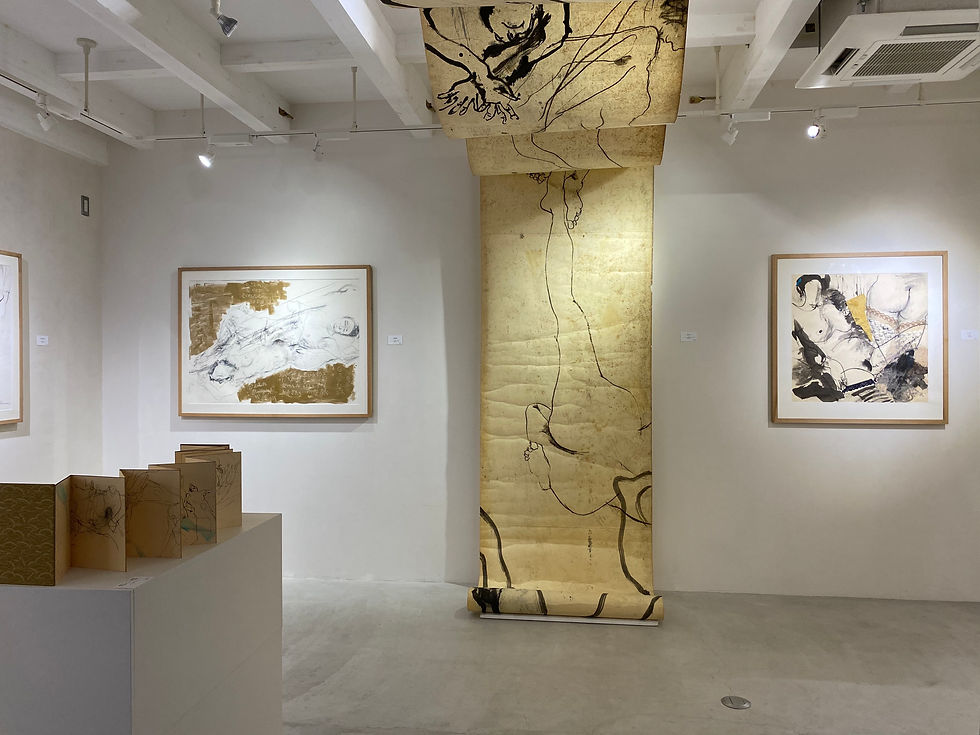
Keisuke Watanabe : Music Is. Music Exists.
15 September - 5 October 2020
Erotic drawings by Kyoto artist Keisuke Watanabe aim to portray the expressive nature of the human body. A master draughtsman, he explores moments and passages of time, revealed through dynamic bodily movement.

Keisuke Watanabe
Clown, 2014
Ink, charcoal, crayon, paper
80 x 110 cm | 31'4 x 43'3 in.
Being a professional musician, Watanabe perceives painting through his musical experience. Music is a temporal art and the artist conceives painting in the same way. His art is born from classical music and develops under its constant influence. His wish to explore the different states of the human body in motion, its sensual appeal is satisfied by extemporaneous sketching on the spot. The artist always works with a live model and creates his paintings in a quick tempo, as if catching the thought in the air. Therefore, in the drawings we see usually a pure experience, sensation unclouded by temporary optics. He creates works in expressionist manner using quick, sensitive lines, favoring blank backgrounds. These works are an exciting example of the effortless virtuosity and a great sense of elegance.

performance at Adelaide Arts Festival. Australia

Life drawings
The artist says that in his paintings “the life is in the lines”. With a vast canvas, he makes full use of the strokes. It is deliberately obvious in “Music Is”, where undressed figures moving chaotically on the surface of a 12 meters long scroll. He stretches and stretches the movements in his painting, as if they were a flow. The distorted proportions in paintings are deliberate. With those distortions, he depicts the movements of the human body and the passage of time.

Keisuke Watanabe
Music Is, 2014
scroll, Ink, charcoal, crayon, paper
100 x 1200 cm | 39'3 x 472'4in.
In 2009 Watanabe received an invitation from Pina Bausch to draw her rehearsals in Wuppertal, Germany.

Keisuke Watanabe works at Pina Bausch rehearsals in Wuppertal

Pina Bausch and Keisuke Watanabe in Wuppertal
A mass of dancers, writhing along to the strident melodies of Stravinsky. They moved chaotically, leaping and jumping and falling and flinging themselves into the air. Keeping in mind that “the horizontal axis is the flow of time,” he followed the dancers just as they were. In this work, he set a high value on “change and unity” and “tension and relaxation”, the things which he has learned from music and which have become the basis for his painting.

Keisuke Watanabe
Sketches of Pina Bausch Dance Troupe rehearsal of “The Rite of Spring”, 2009
digital print accordion book, limited edition
25 x 210 cm | 9'8 x 82'6 in.
In “Lacy,” the sense of distance with the model, a distance from which an outstretched arm would touch her skin, is a key for creation. At that distance, it’s possible to breathe in sync with the model, to feel her body warmth and her scent, and to empathize with her. He gets absorbed with the model. The power of Watanabe’s creative expression resides in his manner to render with extraordinary immediacy of all what is visible at a close range. He is following the motion of the models, scrupulously encompassing every nuance and capturing the tiniest expressions. He does not draw the figures precisely anatomical, but pays a particular attention to the details whether it is hair, fingers or convolutions of lace. The need for details is the point where the real overtakes the imagination. In this sense, details particularize everything while enlarging the boundaries of the saturable space of the painting. The detail may seduce, excite or remind the viewer about some past sensation providing a voyeuristic pleasure or delectation.
While rendering the motion he is able to catch the instantaneity of a moment, which he has chosen intuitively. At one point the body is vibrating, at another the entire body is twisted like a whip or the model in front of the the mirror is touching her foot and the mirror reveals what would otherwise be hidden. The truthfulness of the moment reflects the energy of life with its own texture and singular sensations and leaves its mark on the sheet of paper.
There is something that relates graphics to cinema - the art that operates with the concept off plot development in space. Henri Bergson called this quality duration. Watanabe’s sketches seem to be shot in uncertainty, their shimmering contour has a special musicality of plasticity.
Watanabe achieves a subjective imagery in a conventionally formed space through composition, contour-like construction of figures and color marks. Even a faint amount of color in monochrome sketches, or in works with the various gradations of black-and-white bring out the degree of depth.
It is interesting, that he draws first with a gomagi, a wooden stick burned in the ritual offering of fire. At this point, the composition becomes clear to him. Extraordinary light but sharp lines and smoky shades of black ink highlight the sensual flair of the scene.
painting tools
chalk and coal
crayons
gomagi
stick on which prayers are written, then ritually burnt
bamboo brush
bamboo brush
natural ink stone
bamboo brush
Whatever the subject of Watanabe’s works is or whatever provocative it may look, what matters is the fact that the paintings are not just a sequence of representations. Each of them becomes a scene as if staged in the conventionality of the theatrical scenery. Often in erotic works we are able to discern the sense of irony that is born out from discrepancy between represented image and reality.
Emphatically theatrical scenery in Watanabe's works is correlated with the feeling of a surreal tragedy played out around us. Now when the world endures the coronavirus pandemic, everyone feels the fragility and vulnerability of the human life, realizing its defenselessness. In this context Watanabe’s vitality and erotism reinforce optimism and intensify belief in the power of human energy.














